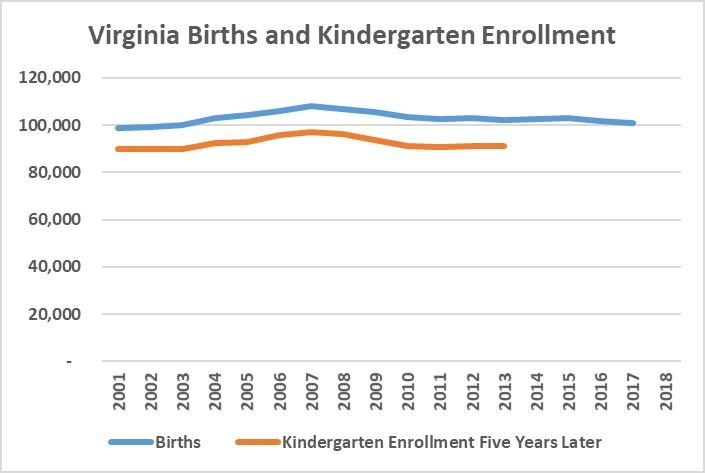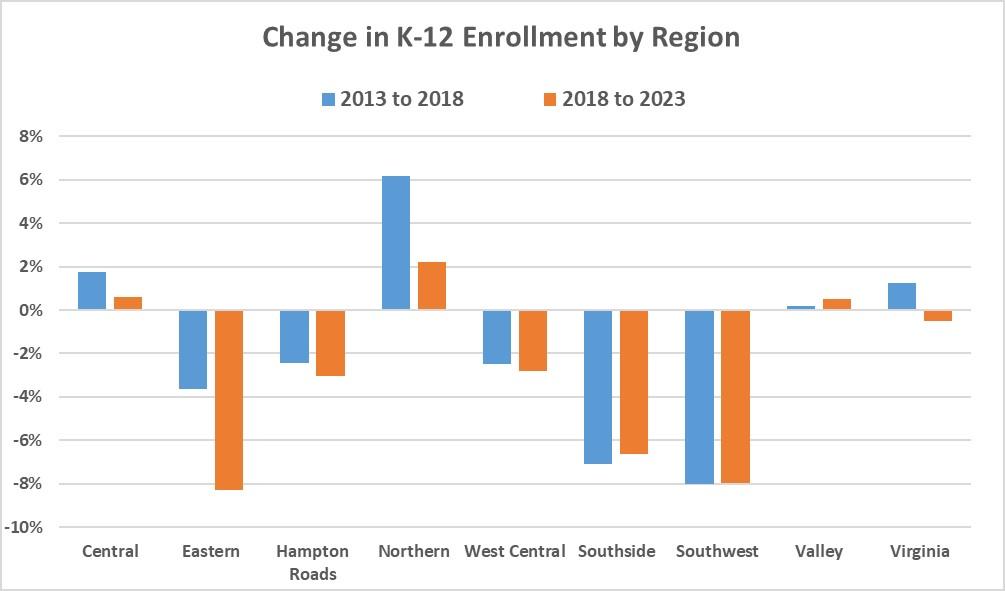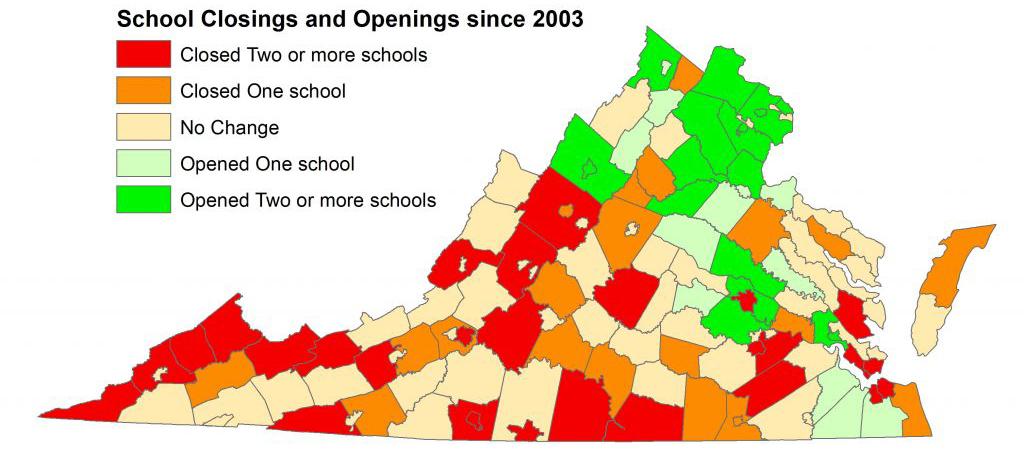Virginia’s school enrollment declined in 2018 for the first time in decades
For decades, Virginia’s public school enrollment has grown steadily along with Virginia’s population, but the results from this year’s September student count show that in 2018, Virginia’s enrollment fell by a little over 2,000 students—the first decline in enrollment since 1984. While this year’s dip in student enrollment is relatively small compared to Virginia’s total public school enrollment (over one million students), the decline in enrollment is one of the first signs that Virginia’s aging population is beginning to impact the commonwealth.

Even though it has been decades since Virginia’s student enrollment last declined, this year’s lower enrollment was not entirely unexpected. The number of births in Virginia, and nationally, has continued to fall since the recession, and as children born after 2007 began enrolling in school, Virginia’s entering kindergarten class sizes also started to shrink. Still, the smaller student cohorts were not expected to cause Virginia’s total student enrollment to decrease until sometime during the 2020s. It appears that this early decline in enrollment is primarily due to the rise in the out-migration of families during the last few years in Northern Virginia.

Since 2010, Northern Virginia and a number of independent cities have accounted for nearly all of Virginia’s student enrollment growth. In 90 of Virginia’s 133 counties and cities, student enrollment has fallen since 2010. In 7 counties, student enrollment has declined by more than 20 percent so far this decade. Until 2018, Northern Virginia’s enrollment growth was large enough to offset enrollment declines in other parts of Virginia, particularly in Hampton Roads, Southside and Southwest, but this year, Northern Virginia’s student enrollment rose by only 1,600 students, after increasing on average by 8,000 students each year this decade.

Given that Virginia’s future kindergarten classes for the next five years have all been born, enrollment trends through 2023 can be projected with a relatively high degree of confidence. Over the next five years, statewide student enrollment is likely to decline moderately, though among Virginia’s regions, enrollment change is likely to be uneven. Enrollment in Northern Virginia should continue to expand, though at a much slower pace than in past years. Central Virginia and the Valley, which have become destinations for many families leaving Northern Virginia, will likely also experience small gains in student enrollment. In much of the rest of Virginia, enrollment decline is likely to accelerate over the next five years. Due to its larger population, Hampton Roads is expected to experience the largest numeric decline in student enrollment, while Eastern, Southside and Southwest will experience the largest percentage declines in student enrollment. By 2023, student enrollment in Southwest Virginia will likely have declined by 19 percent since 2010.

Click here to see the regions’ definition.
In much of Northern Virginia, a slowdown in student enrollment growth may be welcomed by residents who have funded decades of breakneck enrollment growth. In many other parts of Virginia, enrollment decline is less likely to be a relief for residents. In theory, fewer students means less money spent on schools by local government, but the largest percentage declines in student enrollment are occurring in smaller school divisions which have already consolidated schools and shrunk their staff to save money. School consolidation has been so widespread that it is possible to drive from Petersburg to the Cumberland Gap without passing through a division that hasn’t closed a school in the last fifteen years. In many of these divisions, further school consolidation will be increasingly difficult both geographically and politically.

Falling student enrollment also typically means less state funding for school divisions. In order to meet the Virginia Board of Education’s standards of quality, Virginia allocates a specific amount of funding per student to each division based on VDOE’s calculation of their local government’s ability to pay for education costs (The Composite Index). In the short term, fewer students typically mean an immediate drop off in state funding for a division. In the longer term, fewer students in a division can cause their local Composite Index score to increase, which means the local government will need to assume a larger share of their school division’s educational expenses. As a result, rural Virginia counties with large retiree age populations and relatively few public school students, such as Northumberland County, can receive considerably less state funding per student than suburban counties where families with children make up a larger share of the population, such as Prince William County.
Though declining student enrollment is a significant trend within Virginia, it is also a clear indicator of the larger demographic transformation that Virginia, the U.S. and much of the world is undergoing as their populations age. The combination of falling birth rates and increasing life expectancy means that in Virginia and most countries, the number of children is often dwindling while the population over 65 is growing rapidly. Currently, many school divisions are struggling to adapt to shrinking student enrollment, but within a decade, colleges and the workforce will also be forced to adapt as the class size of graduating high school students decreases.


